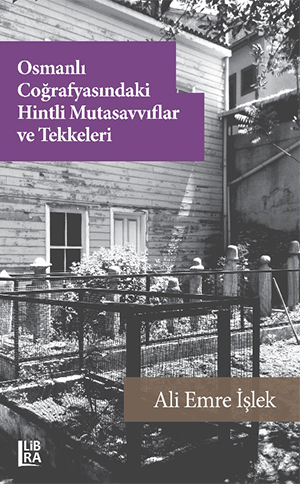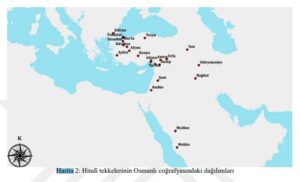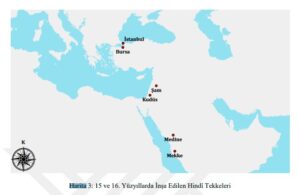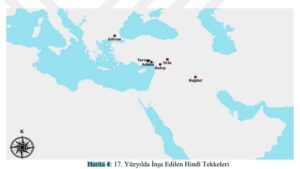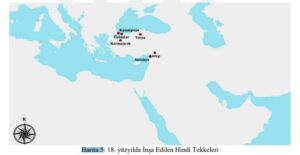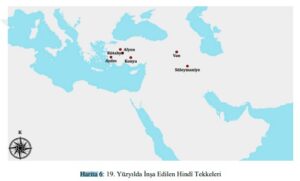Conclusion
To reveal the histories of the Hindu lodges, which had an important place in the Sufi life of the Ottoman period in the context of the breadth of the area they operated and the length of their activity, to determine the names of the sheikhs working in the lodges, to determine the income sources of these lodges, and most importantly, to determine the income sources of these lodges. This study was created in order to evaluate the relations between them from a holistic perspective.
As a result of the study, firstly, as in the case of the lodges in Damascus and Jerusalem, the construction dates of the Hindu lodges date back to the years 1516-1517, when the Ottomans dominated Syria, Palestine, Egypt and the Hejaz. It has been understood that they have an important role in establishing contacts in cultural areas. In this study, the information about the history of the Hindu lodges in Damascus and Jerusalem was concluded with the de facto withdrawal of Syria and Palestine from Ottoman rule in 1917.
However, the fact that the tekke in Jerusalem is still in use as an official building belonging to the Indian state is undoubtedly a mirror reflecting the role of this building in history and today.
In this study, although the narrative about the history of Hindi lodges was terminated with an approach centered on the law on the abolition of lodges-zaviyes in 1925, some of the lodges, including the ones within the borders of the Republic of Turkey, at least survived, and the Hindu lodges in Horhor and Konya. For example, people of Indian origin continued to live here.
Even though the lodges in Damascus and Aleppo, which are outside the borders of the Republic of Turkey, have survived at least as a structure after the end of Ottoman domination in the region, it is likely that they are in ruins due to the ongoing civil war in Syria.
Apart from these two lodges, it is possible that the Hindi lodges in Baghdad and Sulaymaniyah in Iraq were devastated during the long-term wars and turmoil in the region. The Indian ribat and lodges in Mecca and Medina, which are in a sense the heart and center of the Islamic world and civilization, continue to serve as shelters for Indian and Pakistani pilgrims, Sufis and scholars who come and go to these centers to fulfill their pilgrimage.
The two dervish lodges in Bursa and Horhor, which are noteworthy in terms of the length of their activity, were built in the middle of the 15th century under the shadow of a strong Kalenderi tradition.
In terms of the continuity of its activities, the Hindiler Lodge in Bursa had a more stable structure, while the activities of the Horhor Hindiler Lodge were interrupted.
However, only about one percent of the şer’iyye registers, which belong to Istanbul, in which the Hindiler Lodge in Horhor is located, and more than eleven thousand volumes, have been published. With the new and comprehensive studies to be carried out on the Istanbul sharia registers, new data will be obtained on the activities of the Indian sheikhs in Istanbul, even if not on the Horhor Hindiler Lodge.
The Hindiler Lodge in Horhor was built as a central lodge (Âsitâne). Although he had the authority and power before the Indian lodges in the regions, the most important factor in the fact that the lodge came to this state was the active personality of Hacı Ahmed Efendi, who served for a long time from the lodge.
During the sheikhdom of him and his successor, İbrahim Hakkı Efendi, the lodge reached a significant power over other Hindu lodges. When the histories of the Hindi lodges are evaluated in general, it is understood that the 17th and 18th centuries correspond to an important period. During this two-century period, twelve new Hindu Lodges were put into operation, six in the 17th century and six in the 18th century.
Among the Hindu lodges that started operating in the 17th century, the Hindi lodge in Adana stood out in terms of the diversity of its income sources and the size of its outbuildings. The lodge in Tarsus, on the other hand, started to operate in a second building adjacent to the Tomb of Danyal Aleyhisselam, under the direction of a wealthy Indian sheikh named Abdulkayyum, due to the large number of Indian population here, and had an important economic power as in the lodge in Adana.
The fact that Hindi lodges started to be built in Baghdad, Aleppo and Urfa in this century is undoubtedly important in terms of showing the increase in commercial and cultural activities on this route. In the 17th century, many settlements in Anatolia were left in ruins; Considering the circumstances such as the cessation of the activities of the Samsun and Tokat Mevlevi Lodges, the fact that Hindi lodges began to operate in Baghdad, Aleppo and Urfa has been a remarkable development.
With the comparative studies to be made in the following years on the social and economic structures of the Ottoman period Anatolia and the regions that can be geographically named as Syria and Iraq, it is possible to examine the Hindi lodges that started to operate in Baghdad, Aleppo and Urfa. will allow information to be made on a healthier basis.
Among the Hindu lodges that started operating in the 17th century, the most striking one was the lodge in Edirne due to the fluctuations in their activities. It does not seem possible to evaluate the lodge here as the Lodge of the Hindus until the period when it was rebuilt and put into operation by a sheikh named Cafer Hindi, since the sheikhs of the first period of its operation did not carry the rank of Hindu.
Indian sheikhs started to work in the lodge after Cafer Hindi. The main point that draws attention in the history of the lodge is that it was in a dilapidated state again in the last quarter of the 19th century and the activities in the lodge ended so that not even a trace of its building was left.
The 18th century was the most remarkable period in terms of the activities and activities of the Hindu lodges; The most important development in this century was that Horhor Hindiler Lodge came into operation again after a long period of at least seventy years, according to our findings.
The construction of a second lodge, which started to serve the Indians in Üsküdar, in a period of five to ten years following the re-activation of the Hindus Lodge in Horhor, and a sheikh named Turabi-i Hindî in Kasımpaşa had a lodge in Istanbul‘s name during this period. This indicates the existence of a large and active Indian community.
One of the remarkable developments in terms of Hindu lodges in this century was the establishment of two different Indian lodges in close proximity to each other in Antakya. its re-starting. These examples mentioned are important in that they indicate that the Indian sheikhs had a significant power and influence both in Istanbul and in the Ottoman geography in this century.
The activities of the Indian sheikhs continued in the following period and while new lodges were built under the responsibility of the Indians in Aydın, Konya, Karahisar-ı Sahib, Süleymaniye and Van in the 19th century, an old lodge that had been operating in Kütahya since very early dates came under the rule of the Indian sheikhs. Among these newly built lodges, especially the lodge located in the Surtaş district in the Süleymaniye Sanjak, Haji Ahmed Lahori has an important place in terms of being an effective personality.
The fact that Behlül Efendi, one of the last sheikhs of the lodge, which came under the rule of Indian sheiks in Kütahya, also served as the sheikh of La’lizade Abdulbaki Lodge in Istanbul is important in terms of revealing how strong the ties between the Hindu, Uzbek and Afghan communities and lodges are. As a result of the examination of the ties and hierarchical elements between the Hindu lodges, it is understood that it is possible to evaluate the lodges as parts of a network, and it has been revealed that certain procedures and rules have become an established practice in the appointments of the lodges to the sheikh posts.
In the part where the hierarchical elements between the dervish lodges are discussed, some important issues in the histories of the dervish lodges are discussed again as a whole. As a result of this situation, it has been determined how the management of the dervish lodges is provided and what difficulties are encountered in this regard. In the evaluations of the place of the Hindu lodges in the life of Sufism in the Ottoman period, firstly, the issue of which sects were active in the lodges was emphasized.
As a result of these evaluations, although exceptional situations have occurred, it has been revealed that the dominant order in Hindi lodges is Qadirism. After the evaluations about the order dominant in the lodges, the names of the Indian sheikhs who had a role in the Ottoman religious and cultural life with their works were determined and information about their works was given.
Osmanlı Coğrafyasındaki Hintli Mutasavvıflar ve Tekkeleri – Libra Kitap
Osmanlı Devleti’nde Hindî Tekkeleri (Indian Dervish Lodges in Ottoman State)
Ali Emre Islek
2020, Ph.D. Thesis

